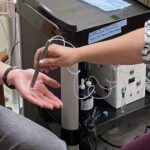
In a groundbreaking advancement that could change the landscape of brain cancer treatment, researchers at Virginia Commonwealth University’s Massey Comprehensive Cancer Center and the Institute of Molecular Medicine (VIMM) have unveiled a novel therapeutic approach targeting glioblastoma (GBM) — the deadliest and most aggressive form of primary brain cancer. This innovation centers on the creation of a “Fusion Superkine” (FSK), a hybrid molecule engineered to combine two powerful cytokines with the potential to both eradicate tumor cells and stimulate the immune system to prevent cancer recurrence. This dual-action molecule was pioneered by Dr. Paul B. Fisher and Dr. Swadesh K. Das, whose team recently published their findings in the prestigious Journal for ImmunoTherapy of Cancer.
Glioblastoma is notoriously difficult to treat due to its highly invasive and malignant nature, compounded by its classification as an immunologically “cold” tumor. This means the tumor microenvironment actively suppresses immune activity, thwarting conventional immunotherapies’ effectiveness. Nearly all GBM patients experience tumor recurrence within six to nine months post-treatment, and recurrent tumors often develop resistance to chemotherapy and radiation, leading invariably to patient mortality. Current therapeutic strategies address symptoms and slow progression but fail to offer curative outcomes, thus underscoring the urgent need for innovative solutions.
The researchers sought to address these challenges by designing a fusion molecule that simultaneously delivers the cytotoxic effects necessary to kill tumor cells and the immunomodulatory signals required to activate the body’s immune defenses. This FSK is composed of an enhanced form of Interleukin-24 (IL-24S), renowned for its tumor-selective cytotoxicity, coupled with Interleukin-15 (IL-15), a potent immune-stimulating cytokine known to activate natural killer (NK) cells and T lymphocytes. The fusion aims to overcome the immunosuppressive microenvironment of GBM, effectively converting a “cold” tumor into an immunologically active battlefield.
.adsslot_V1aLTAYm4Q{width:728px !important;height:90px !important;}
@media(max-width:1199px){ .adsslot_V1aLTAYm4Q{width:468px !important;height:60px !important;}
}
@media(max-width:767px){ .adsslot_V1aLTAYm4Q{width:320px !important;height:50px !important;}
}
ADVERTISEMENT
Testing this molecule in an immunocompetent mouse model of glioblastoma revealed striking therapeutic outcomes. The FSK demonstrated superior tumor regression and prolonged survival compared to treatments involving either IL-24S or IL-15 alone. Crucially, the therapy not only induced direct tumor cell death but also enhanced infiltration of key immune cells—including T cells, dendritic cells, macrophages, and NK cells—within the tumor microenvironment. This suggests the treatment orchestrates a coordinated immune assault, improving both local control and potentially systemic antitumor immunity.
Delivering therapeutic agents effectively to the brain has been a longstanding hurdle due to the blood-brain barrier (BBB), a highly restrictive physiologic interface that prevents most molecules and viruses from reaching CNS tumors. To circumvent this challenge, the team engineered a delivery system that utilizes a type 5 adenovirus vector to express the fusion superkine. Not stopping there, they innovatively paired this vector with a noninvasive, targeted delivery technique employing focused ultrasound (FUS) combined with intravenously infused microbubbles (MBs). This focused ultrasound double microbubble (FUS-DMB) method transiently and safely opens the BBB, allowing the adenovirus vector carrying the FSK to penetrate the brain’s protective barrier and deliver its payload directly to the tumor.
The FUS-DMB technique operates by inducing oscillation and cavitation of microbubbles within cerebral blood vessels under ultrasound exposure, leading to reversible disruption of tight junctions in the endothelial cells forming the BBB. This temporary permeability boosts penetration of the viral vector without causing neurological damage or eliciting significant inflammation, a major advancement over invasive surgical delivery methods or systemic treatments with poor CNS bioavailability. The ability to precisely and safely shuttle gene therapy vectors into brain tissue could herald a new era for treating brain pathologies beyond glioblastoma—including metastases and neurodegenerative diseases.
Dr. Paul B. Fisher emphasized the novelty and transformative potential of this approach, expressing optimism about an upcoming clinical trial projected to launch in 2026. This trial will investigate the safety and efficacy of the IL-24 gene therapy and accompanying viral delivery methods in glioblastoma patients. According to Fisher, the fusion superkine and FUS-DMB delivery together could represent an unprecedented “knockout” solution for brain cancer, aiming to achieve what has so far proved elusive—the elusive “holy grail” of a cure for this devastating disease.
Complementing Fisher’s vision, Dr. Swadesh K. Das highlighted the fusion superkine as a differentiated platform that simultaneously accomplishes tumor cell eradication and localized immune activation. By merging gene therapy with advanced immunotherapy principles, the treatment is designed not only to attack established tumors but also to establish durable immune memory, potentially preventing relapse. Such immunological “education” of the host immune system is critical given glioblastoma’s notorious tendency to evade conventional therapies and redevelop.
Peers reviewing the study echoed its significance, noting that previous efforts to develop adenoviral vectors co-expressing multiple therapeutic genes have been hampered by technical hurdles such as impaired viral assembly or inadequate gene expression. The successful construction of the Ad5FSK vector, co-expressing IL-24S and IL-15 without compromising viral function, marks a major milestone in viral immunotherapy. Moreover, the noninvasive FUS-DMB delivery system further elevates the approach’s translational potential by overcoming delivery challenges unique to the brain’s anatomy.
Importantly, the FUS-DMB platform’s versatility extends beyond glioblastoma treatment. By enhancing delivery of viral and molecular therapeutics across the BBB, this technology could be adapted to target other intracranial tumors or neurological disorders requiring CNS gene delivery. The increased targeting precision and systemic administration route represent powerful advantages over localized, invasive delivery techniques traditionally employed in neuro-oncology and neurology.
Looking ahead, the research team plans to expand preclinical testing using clinical GBM tumor samples and to eventually transition into human trials. The long-term vision includes applying this combined fusion superkine and focused ultrasound delivery strategy to not only primary brain cancers but also secondary brain tumors arising from metastases outside the CNS. Such advancements could profoundly alter the treatment paradigm, moving from palliative interventions towards noninvasive cures.
This innovative study was supported by numerous funding entities, including the National Foundation for Cancer Research and the National Cancer Institute, and involved a multidisciplinary collaborative team spanning molecular biology, immunology, neurosurgery, and biomedical engineering. The authors disclosed relevant ties to InterLeukin Combinatorial Therapies, Inc., reflecting ongoing translational and commercialization paths for this promising technology.
In summary, the creation of a fusion superkine that couples the selective tumoricidal power of IL-24S with the immune mobilizing capacity of IL-15, delivered through an ingeniously designed noninvasive focused ultrasound microbubble platform, stands out as a pioneering breakthrough in glioblastoma immunotherapy. This multifaceted treatment not only achieves potent tumor cell killing but also harnesses and revitalizes the immune system’s ancient defenses within the brain’s hostile environment. If clinical trials validate these findings, patients suffering from glioblastoma may soon have access to a therapy with curative potential, breaking a long-standing impasse in brain cancer treatment that has persisted for decades.
Subject of Research: Animals
Article Title: Novel fusion superkine, IL-24S/IL-15, enhances immunotherapy of brain cancer
News Publication Date: 21-Jun-2025
Web References:
Journal for ImmunoTherapy of Cancer Article
DOI: 10.1136/jitc-2024-011198
Image Credits: VCU Massey Comprehensive Cancer Center
Keywords: Brain cancer, Glioblastomas, Blood brain barrier
Tags: brain cancer treatmentcombating tumor recurrenceDr. Paul B. Fisher researchdual-action cancer therapiesfusion superkine therapyglioblastoma research breakthroughsimmune system stimulation in cancerimmunotherapy for brain tumorsinnovative cancer treatment strategiesnovel glioblastoma therapiesovercoming immunologically cold tumorsVCU Massey Cancer Center advancements


